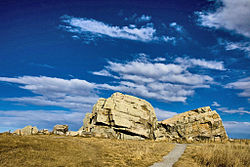Okotoks Erratic
Big Rock | |
|---|---|
 | |
| Coordinates: 50°42′21.18″N 114°04′35.12″W / 50.7058833°N 114.0764222°W | |
| Location | near Okotoks, Alberta |
| Formed by | quartzite |
| Geology | glacial erratic |
| Topo map | NTS 82J9 Turner Valley |
Okotoks Erratic (also known as either Big Rock or, in Blackfoot, as Okotok) is a 16,500-tonne (18,200-ton) boulder that lies on the otherwise flat, relatively featureless, surface of the Canadian Prairies in Alberta. It is part of the 930-kilometre-long (580 mi) Foothills Erratics Train of typically angular boulders of distinctive quartzite and pebbly quartzite.
This massive angular boulder, which is broken into two main pieces, measures about 41 by 18 metres (135 by 60 feet) and is 9 m (30 ft) high. It consists of thick-bedded, micaceous, feldspathic quartzite that is light grey, pink, to purplish. Besides having been extensively fractured by frost action, it is unweathered. Big Rock lies about 8 km (5 mi) west of the town of Okotoks, Alberta, Canada, 18 km (11 mi) south of Calgary in the SE. 1/4 of Sec. 21, Township 20, Range 1, West 5th Meridian.[1][2]
Big Rock is a glacial erratic that is part of a 930 km (580 mi) long, narrow (1.00 to 22.05 km (0.62 to 13.7 mi) wide), linear scatter of thousands of distinctive quartzite and pebbly quartzite glacial erratics between 30 cm (1 ft) and 41 m (135 ft) in length. This linear scatter of distinctive quartzite glacial erratics is known as the Foothills Erratics Train. The Foothills Erratics Train extends along the eastern flanks of the Rocky Mountains of Alberta and northern Montana to the International Border. The boulders and smaller gravel, which comprises the Foothills Erratics Train, consist of Lower Cambrian shallow marine quartzite and conglomeratic quartzite, which occurs only within the Gog Group and is found in the Athabasca River Valley of central western Alberta. Big Rock is the largest erratic within the Foothills Erratics Train. Lying on prairie to the east of the Rocky Mountains and like all the larger erratics, it is visible for a considerable distance across the prairie and likely served as a prominent landmark for Indigenous people.[1][2][3][4]
- ^ a b Stalker, A MacS (1975). "The big rock." In Structural geology of the foothills between Savanna Creek and Panther River, S.W. Alberta, Canada. May 23, 1975. H. J. Evers and J. E. Thorpe, eds., pp. 9-11. Calgary, Alberta, Canada: Canadian Society of Petroleum Geologists.
- ^ a b Cruden, DM, W Langenberg, and RC Paulen (2003). Geology of the Frank Slide and southwestern Alberta. Edmonton Geological Society – Geological Association of Canada annual field trip celebrating the 100th anniversary of the Frank Slide Disaster. Edmonton, Alberta: Edmonton Geological Society. 34 pp.
- ^ Stalker, A MacS (1956). "The erratics train, Foothills of Alberta." Geological Survey of Canada, Bulletin no. 37, 28 p.
- ^ Jackson, Lionel E.; Fred M. Phillips; Edward C. Little (1999). "Cosmogenic 36Cl dating of the maximum limit of the Laurentide Ice Sheet in southwestern Alberta". Canadian Journal of Earth Sciences. 36 (8): 1347–1356. doi:10.1139/cjes-36-8-1347. Archived from the original on 2005-05-13.
